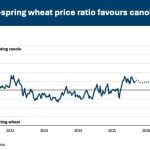SINGAPORE, MOSCOW (Reuters) – Russia’s ambition to grab a slice of Asia’s lucrative wheat business will likely take longer than the planned two or three years.
Transport hurdles and consumer reluctance to adapt to new supplies are expected to slow Moscow’s campaign.
Growing production and bulging stockpiles have sent Russia to the biggest wheat importers in Asia, a market so far ruled by Australia and the United States.
It expects shipments to climb in the years ahead.
Read Also

Farmers urged to be grain-safe this fall
Working around grain bins comes with risk, from farmers falling to drowning in grain: Experts have five tips to help avoid grain-related accidents this harvest.
The move is part of Russia’s strategy to develop its grain export infrastructure to double shipments to 35 to 40 million tonnes by 2015.
If successful, the campaign will add to pressure on Chicago wheat prices, which have wilted 30 percent from last year’s peak after Russian and European suppliers won tenders in U.S. strongholds Egypt and the Middle East.
Russia has already grabbed a sizable share of sales in what are the world’s biggest wheat importers, a worry for suppliers in the roughly $5 billion US a year Asian market.
“For Russia to have a big impact in Asia, two hurdles will need to be leaped: logistics and quality,” said Scott Briggs, an agricultural commodity strategist with ANZ in Melbourne, Australia.
“Most Russian exports currently go into Africa and the Middle East, where they have freight and cost of production advantages.”
Russia is in direct talks with millers in Japan, Indonesia and Bangladesh to sell high-quality Siberian wheat, which is similar to varieties such as U.S. hard red winter wheat and Australian prime hard wheat.
The Russian Grain Union lobby group expects grain shipments to Asia to rise to 1.5 to two million tonnes by 2012 from an estimated 500,000 tonnes in 2009.
The Russian government hopes to sell one million tonnes of wheat to Japan by 2011 and is in talks to supply 300,000 tonnes to Bangladesh in a government-to-government deal.
However, traders and analysts said its strategy to make inroads into Asia is easier to chalk out than execute.
A major stumbling block is the lack of east coast infrastructure such as grain elevators, silos and ports that are capable of servicing large ships.
Russia also needs to reduce the $60 to $90 per tonne cost of transporting Siberian wheat 4,000 to 6,000 kilometers from its growing regions to ports on the east coast.
Russia plans to invest up to $100 million over two to three years to refurbish ports on its east coast as it moves to cut shipping time to Asia to just a few days from the 25 days now needed to send grain through Black Sea ports.
Asian importers accustomed mainly to Australian and U.S. wheat are unlikely to switch to the Siberian grain unless they think it is substantially cheaper and are sure about the quality.
“We don’t know the characteristics of Siberian wheat. I think it will take time before Russian milling wheat can participate in the Japanese market,” said Nobuyuki Chino, president of Tokyo-based trading company Unipac Grain.
“It will be an extremely slow process … maybe a few hundred thousand tonnes initially.”
Asia imports more than 20 million tonnes of wheat a year, with top regional buyers Japan, South Korea and Indonesia taking 14 million tonnes. Smaller buyers such as Malaysia, Bangladesh, Vietnam, Thailand and the Philippines take the rest.
Wheat processors are picky about grain quality, using specific varieties to make bread, cakes, biscuits and noodles.
About one million tonnes of Australian standard wheat goes into Japan’s popular udon noodles each year, while bread is made from U.S. dark northern spring and noodles are made from Canadian spring wheat and Australian prime hard wheat.
Western white wheat is good for baking cakes and biscuits.
Switching origins for animal feed grain, such as corn and soybeans, is easier because the key concern is protein content, traders said.
“Wheat is a difficult commodity compared with corn and soybean meal, which are essentially fed to animals,” said Genichiro Higaki, head of the proprietary fund management team at Sumitomo Corp. in Tokyo.
“Even if they offer cheap, I don’t think huge volumes will move until the quality matter is cleared.”
Some traders said Russia would initially target smaller and more price sensitive players such as Bangladesh, Vietnam and Malaysia.
“The Japanese market will be tough, but South Korea may be a bit easier as they take some amount of feed wheat,” said one trading manager with an international commodities firm in Singapore.
U.S. wheat also has a $10 to $15 freight disadvantage for shipments to key Middle East and African markets. High U.S. prices and abundant global wheat supplies allow major importers to be more selective and buy nearer home.
Although Russian wheat does not pose an immediate threat to Australian and U.S. wheat in Asia, analysts say it will be a wake-up call to those countries’ producers.
“It does turn the spotlight back on the necessity to remain competitive,” said Briggs, adding that lower freight rates promised to slash the attractiveness of Australian grain even before low Russian production costs were considered.
“Thanks to both a bigger fleet and bigger volumes of grain from the Black Sea into Asia, the current positive freight differential Australia exhibits will be eroded before even speaking about the lower costs of production out of that region.”














